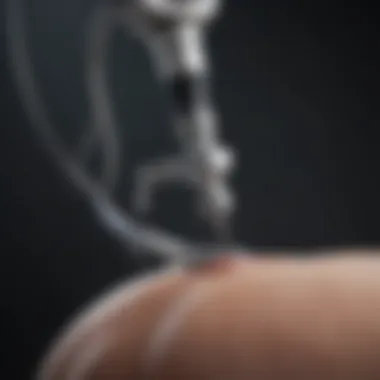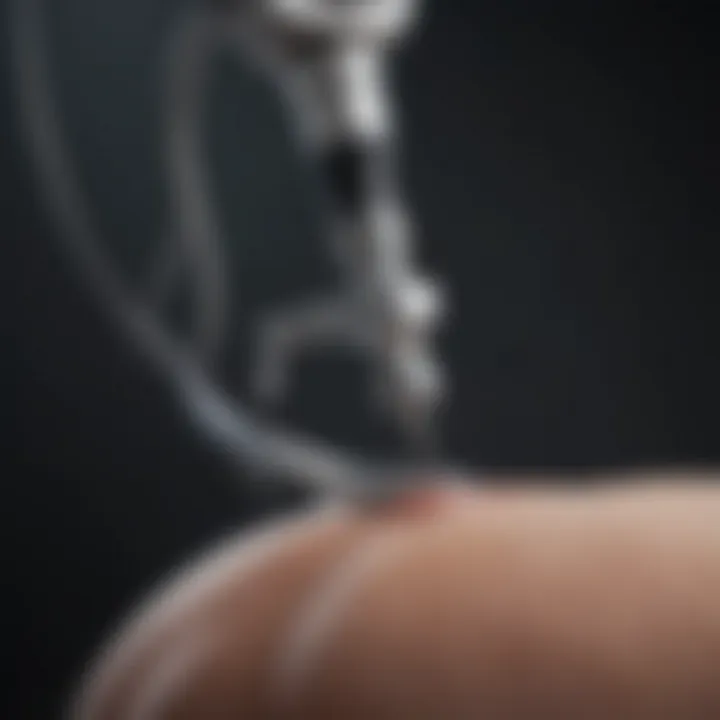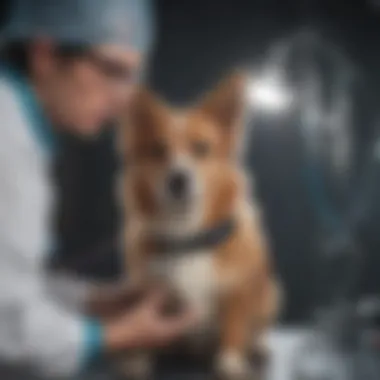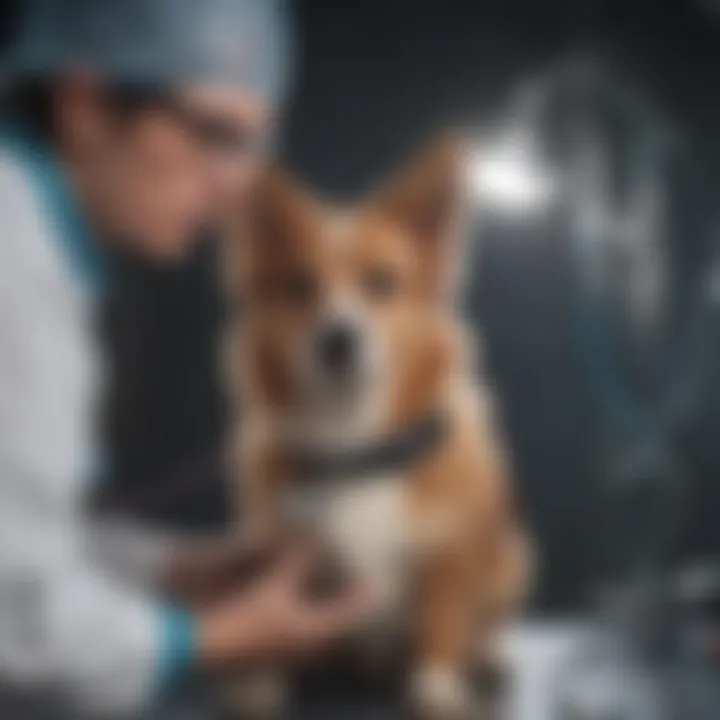Laparoscopic Neutering for Male Dogs: An Overview


Intro
Laparoscopic neutering, a minimally invasive surgical technique, presents significant advancements in veterinary medicine, particularly for male dogs. This technique offers several advantages over traditional neutering methods, which can involve longer recovery times and increased pain for the animal. Understanding laparoscopic neutering is essential for pet owners, veterinary professionals, and researchers, as it transforms how we approach canine reproductive health.
This article explores both the procedure itself and the broader implications of laparoscopic neutering on health and well-being. It also addresses recovery advantages and pain management strategies that make this technique increasingly attractive. By doing so, we can better understand the future of veterinary practices and the impact on canine life quality.
Key Findings
Laparoscopic neutering incorporates a few key findings that set it apart from traditional methods:
- Rapid recovery times: Animals undergoing laparoscopic procedures typically experience shorter recovery periods, allowing them to resume normal activities much sooner.
- Less postoperative pain: The technique often results in minimal tissue damage. This contributes to reduced pain and discomfort during the healing process.
- Lower complication rates: Laparoscopic techniques can lead to fewer surgical complications, further benefiting the patient.
Major Results
Research indicates that dogs undergoing laparoscopic neutering displayed significantly fewer signs of pain compared to those who had traditional surgeries. Studies suggest a decrease in the need for pain medications post-surgery, enhancing the overall experience for both the animal and the owner.
Discussion of Findings
The implications of these findings are significant. Reduced recovery times mean that pet owners can expect their dogs to be back to their playful selves much quicker. This is particularly important for those owners who schedule surgeries around busy routines or for working individuals. Moreover, minimizing pain can enhance a dog’s overall health and long-term outcomes.
Methodology
Understanding the methodology behind laparoscopic neutering is crucial for evaluating its effectiveness and safety.
Research Design
The design of studies on laparoscopic neutering typically focuses on comparing outcomes against traditional methods. Researchers often employ randomized controlled trials to ensure reliable and valid results.
Data Collection Methods
Data is collected through:
- Clinical assessments: Monitoring pain levels, recovery times, and any postoperative complications.
- Owner surveys: Gathering subjective data from pet owners regarding their dogs’ behavior and health following surgery.
- Veterinary reports: Documenting the technical aspects of the procedure and any observed differences in outcomes.
"The shift towards laparoscopic techniques represents a significant milestone in veterinary surgery, advocating for enhanced animal welfare and recovery processes." - Veterinary Research Journal
Preamble to Laparoscopic Neutering
Laparoscopic neutering represents a significant advancement in the field of veterinary medicine, particularly in the context of male dogs. This innovative surgical technique offers several benefits over traditional methods, thereby evolving the standard approach to pet neutering. Understanding the importance of laparoscopic neutering is crucial for pet owners, veterinarians, and anyone involved in animal welfare.
The traditional approach to neutering male dogs has often involved larger incisions, longer recovery times, and variable pain management. In contrast, laparoscopic neutering allows for smaller incisions and a minimally invasive technique, which can result in improved post-operative outcomes. The significance of this procedure lies not only in the technical aspects, but also in how it enhances the overall health and well-being of canine patients.
Definition of Laparoscopic Neutering
Laparoscopic neutering, also known as laparoscopic orchiectomy, refers to a minimally invasive surgical procedure for the removal of the testes in male dogs. This technique utilizes a laparoscope, which is a thin tube with a camera and light, to guide the surgeon through a small incision in the abdomen. The advantages of this approach include a reduction in tissue damage, less pain for the animal, and a quicker return to normal activity.
Historical Context and Development
The practice of neutering pets has evolved considerably over the years. Traditional surgical methods have been used for decades, but advancements in technology have paved the way for new procedures. Laparoscopic techniques emerged in human medicine in the late 20th century and gradually made their way into veterinary surgery. Initial studies indicated the potential for improved outcomes with laparoscopic approaches, leading many veterinary schools and clinics to adopt this method. Today, the refinement of laparoscopic neutering continues to gain recognition and endorsement among veterinary professionals, highlighting its importance in modern veterinary practices.
Understanding Canine Reproductive Health
Understanding the reproductive health of male dogs is essential for a variety of reasons. It informs pet owners and veterinary professionals about the implications of neutering. Knowledge of this topic can contribute to better care and management of canine health, promote responsible breeding practices, and reduce the prevalence of unwanted litters. Moreover, recognizing the anatomy and physiology of male dogs plays a pivotal role in enhancing surgical outcomes in procedures like laparoscopic neutering. By understanding these concepts, owners are empowered to make informed choices regarding their pets' health and well-being.
Anatomy of Male Dog Reproductive System
The male dog reproductive system is composed of several key structures: the testes, epididymis, ductus deferens, prostate gland, and penis.
- Testes: These are two oval organs located in the scrotum. Their primary function is the production of sperm and hormones, such as testosterone.
- Epididymis: The epididymis is a coiled tube where sperm mature and are stored before ejaculation. It closely follows the testes.
- Ductus Deferens: This muscular tube transports sperm from the epididymis to the urethra during ejaculation.
- Prostate Gland: This gland produces seminal fluid, which nourishes and transports sperm during ejaculation.
- Penis: The penis is essential for mating and delivering sperm to the female's reproductive tract.


A clear comprehension of these anatomical structures is crucial for surgical planning and intervention. Accurately identifying these organs during laparoscopic procedures can minimize complications and enhance recovery for the animal.
Common Health Issues Related to Neutering
Neutering, while beneficial, can also be associated with specific health concerns. Awareness of these issues is vital for pet owners. Some common health problems linked to neutering include:
- Obesity: Neutered male dogs may have a higher propensity for weight gain. It is essential to adjust their diets and maintain exercise post-neutering.
- Urinary Incontinence: Some male dogs may experience incontinence after the procedure, particularly if they are neutered at a young age.
- Behavioral Changes: Neutering can influence behavior. While it often reduces aggression or marking behavior, some dogs may still exhibit undesirable traits.
- Joint Issues: Studies indicate that certain breeds may have an increased risk of joint dysplasia after neutering.
Preventative Measures: Owners should discuss these potential issues with their veterinarians, ensuring that they monitor their pets post-surgery and provide adequate care.
Awareness of these health concerns ensures that pet owners can take proactive steps to mitigate risks. Overall, understanding canine reproductive health leads to better outcomes in procedures like laparoscopic neutering.
The Laparoscopic Procedure Explained
The laparoscopic procedure in neutering male dogs represents a significant advancement in veterinary medicine. This technique reduces the invasiveness of traditional surgical methods and streamlines the overall process for both the veterinary professionals and the pets. By focusing on specific elements such as pre-operative preparation, surgical steps, and post-operative care, one can appreciate the complexity and precision involved in this approach. The benefits of laparoscopic neutering extend beyond just the immediate surgical process, including shorter recovery times and less trauma to the animal. In understanding this procedure, it becomes clear why it is gaining traction in veterinary practices.
Pre-Operative Preparation
Pre-operative preparation is an essential phase that lays the groundwork for a successful laparoscopic neutering procedure. This step usually entails comprehensive health assessments, including blood tests and physical examinations, to ensure that the dog is fit for anesthesia and surgery. Proper fasting prior to the operation is also necessary to minimize the risk of complications related to anesthesia.
Additionally, educating the pet owner about the procedure, risks, and post-operative care requirements is crucial. This involvement not only helps in alleviating anxiety but also ensures the owner understands the importance of post-op monitoring.
Step-by-Step Surgical Process
The laparoscopic surgical process can be broken down into several distinct phases, each critical to the overall success of the procedure.
Initial Incision Techniques
Initial incision techniques are fundamental to accessing the surgical site with minimal disruption to surrounding tissues. In laparoscopic procedures, very small incisions are made, usually 0.5 to 1 centimeter in length. This reduces recovery time significantly.
A key characteristic of this technique is that it minimizes the trauma experienced by the dog during surgery. The smaller cuts also mean lesser bleeding and quicker healing, which is a beneficial aspect for both the veterinarian and the patient. However, precision in making these incisions is crucial, as improper technique may hinder the surgeon's ability to view the operative field clearly.
Use of Carbon Dioxide for Insufflation
The use of carbon dioxide for insufflation plays a vital role in laparoscopic surgery. This process involves inflating the abdomen with carbon dioxide gas to create a working space for the surgical instruments. A significant detail here is that carbon dioxide is rapidly absorbed by the body, which limits the amount of time it poses a risk to the dog.
The key advantage of this technique is its capability to provide sufficient visibility without excessive manipulation of the abdominal organs. However, proper insufflation must be carefully monitored to prevent complications such as gas embolism.
Removal of Testes
The removal of testes, or orchiectomy, is the final act of the surgical procedure. This step is typically performed using graspers and scissors through the laparoscopic ports. A notable characteristic of this technique is the ability to complete the task using minimal alteration to surrounding anatomy.
This method is considered popular due to its efficiency and the reduced risk of complications associated with traditional neutering. However, there still remains a need for skilled surgeons to confidently execute the procedure.
Post-Operative Care
Post-operative care is a critical aspect of the laparoscopic procedure that directly influences the dog's recovery process. This stage involves monitoring the pet closely for signs of complications, managing pain effectively, and ensuring a calm environment for healing. Pet owners play a pivotal role in this stage, as their attention to detail can prevent serious issues during recovery. Monitoring the surgical sites for any signs of infection or abnormal swelling can help support a smooth recovery.
Advantages of Laparoscopic Neutering
Laparoscopic neutering offers several notable advantages when compared to traditional methods. Understanding these benefits is vital for pet owners, veterinarians, and anyone interested in animal health. The article will highlight key elements that make this surgical approach a preferable option in many cases.
Minimally Invasive Nature
One of the fundamental benefits of laparoscopic neutering is its minimally invasive nature. Unlike traditional neutering, which usually requires a larger incision, the laparoscopic technique uses small incisions to perform the surgery. This means that the trauma to the tissues is significantly lowered. Additionally, the instruments and camera used in the laparoscopic procedure allow for a clearer view of the internal organs. This precision leads to better outcomes in many situations. As the recovery process is generally less traumatic, many dogs experience less pain after laparoscopic surgery.
Reduced Recovery Time
Another compelling advantage is the reduced recovery time associated with laparoscopic neutering. Since the procedure is less invasive, dogs typically recover faster compared to those who undergo traditional methods. Many patients can return to their normal activities within just a few days. This is beneficial not only for the dogs but also for their owners, who may have to manage post-operative care. In a survey conducted among pet owners, a considerable percentage reported satisfaction with shorter recovery periods. Many said that their dogs resumed regular activities, such as running and playing, much sooner than expected.


Lower Risk of Complications
The laparoscopic approach also demonstrates a lower risk of complications. The smaller incisions reduce the chances of infection and allow for better wound healing. Although complications in any surgical procedure are always a possibility, the laparoscopic method minimizes these risks. A study published in veterinary journals highlights that laparoscopic neutering resulted in a lower incidence of adverse effects compared to traditional techniques. Less blood loss during surgery is another advantageous factor. This contributes to overall better health outcomes in dogs post-surgery.
"Laparoscopic neutering is a leap forward in surgical techniques. It reduces pain and promotes a quicker recovery for our pets."
In summary, laparoscopic neutering provides a range of benefits, including its minimally invasive nature, reduced recovery times, and lower risk of complications. As veterinarians continue to adopt these advanced techniques, their impact on canine health can be profound, making this surgical method a critical consideration for pet owners.
Limitations and Considerations
The discussion around laparoscopic neutering for male dogs must address its limitations and considerations. While this technique boasts numerous benefits, pet owners and veterinarians need to be aware of certain factors that may influence their choices. Understanding these elements can guide responsible decision-making regarding canine neutering.
Cost Implications
The financial aspect of laparoscopic neutering cannot be overlooked. Compared to traditional neutering methods, laparoscopic procedures often come with higher costs. This is primarily due to advanced technology, specialized surgical tools, and the need for a trained veterinarian. Such expenses may deter some pet owners from choosing laparoscopic neutering, even when they recognize its benefits.
Prepare for possible additional costs associated with pre-operative assessments, post-operative care, and the initial consultation. Budgeting effectively can help pet owners make informed choices based on their financial capabilities. It is also essential to compare the long-term health benefits against the upfront costs, as potential savings in veterinary visits for complications might outweigh initial expenditures.
Availability of Skilled Surgeons
Another significant limitation is the availability of skilled surgeons trained in laparoscopic techniques. Not all veterinary practices offer this advanced surgical option. As a result, clients might need to travel long distances to access qualified veterinarians. This limitation can be particularly challenging for those in rural areas where specialized veterinary services are scarce.
Finding a practitioner with sufficient experience in laparoscopic neutering is crucial. Pet owners should research local clinics and review their qualifications. Engaging with your local veterinary community may provide recommendations and insights into available resources.
Potential for Complications
Like any surgical procedure, laparoscopic neutering carries potential risks and complications. While the minimally invasive nature reduces certain risks, it does not eliminate them entirely. Complications can arise from anesthesia, bleeding, or infection, albeit at a lower frequency than with traditional methods.
Pet owners should be informed about these risks and prepared for the possibility of post-operative issues. Surgeons typically provide comprehensive information on expected outcomes and care instructions. Closely following post-operative guidelines is vital to mitigate potential complications. Having an understanding of what to look for during recovery can help ensure the best outcomes for the pet.
"Awareness of the limitations and considerations surrounding laparoscopic neutering enables pet owners to make informed decisions that prioritize their dog's health and wellbeing."
Comparison to Traditional Neutering Methods
The topic of comparison between laparoscopic neutering and traditional neutering methods plays a crucial role in understanding the modern approaches to canine reproductive health. This section identifies significant differences, advantages, and drawbacks associated with each method, ultimately guiding pet owners and veterinary professionals in making informed decisions.
Surgical Techniques Overview
The surgical techniques utilized in traditional neutering differ markedly from those used in laparoscopic procedures. Traditional methods often involve an open surgery approach, which requires larger incisions to remove the testes. This can lead to increased trauma to the surrounding tissues, longer surgery times, and possibly a higher risk of complications such as bleeding or infection.
In contrast, laparoscopic neutering uses minimally invasive techniques. Here, smaller incisions are made, which reduces tissue damage significantly. This approach typically employs specialized instruments and cameras to perform the surgery while allowing the veterinarian to have a clear view of the internal structures.
Some specific surgical techniques in laparoscopic neutering include:
- Laparoscope Utilization: A laparoscope, or a special camera, is inserted through a small incision. It provides magnified images of the surgical field.
- Electrocautery: This technique helps in sealing blood vessels during surgery, minimizing bleeding.
- Trocar Techniques: Small, sharp devices known as trocars are used to create entry points into the abdominal cavity.
These modern surgical methods are designed to improve outcomes for the dog, ensuring a safer and less invasive experience when compared to conventional techniques.
Recovery Comparisons
When evaluating recovery following neutering, the differences between laparoscopic and traditional methods are significant. Traditional neutering often entails a lengthier recovery period. Pets may experience substantial pain post-surgery due to the extensive tissue trauma, which can extend their hospital stay and the time before normal activity can resume.
In contrast, dogs undergoing laparoscopic neutering tend to recover much quicker. The minimally invasive nature of the technique results in:
- Reduced Surgical Trauma: Lesser tissue damage leads to a decrease in postoperative pain.
- Shorter Hospital Stay: Many dogs can go home the same day.
- Faster Return to Normal Activities: Dogs can usually resume their regular routines after only a few days.
Research suggests that dogs that have laparoscopic neutering are less likely to exhibit behavioral changes or complications post-surgery. This evidence supports the notion that laparoscopic techniques offer a more favorable recovery trajectory compared to traditional methods, establishing a clear advantage for both pets and their owners.
Ethical Considerations in Neutering
The topic of ethical considerations in neutering is vital in the discussion of laparoscopic neutering for male dogs. Understanding the implications, benefits, and moral responsibilities involved can profoundly shape pet owners' and veterinary professionals' decisions. This section delves into two crucial aspects: balancing animal welfare with population control, and the importance of informed consent and education.
Balancing Animal Welfare and Population Control
Neutering serves as a powerful tool in managing animal populations and preventing unwanted litters. Millions of dogs enter shelters yearly, and many are euthanized due to overpopulation. Laparoscopic neutering presents an opportunity to minimize this issue while ensuring the animal’s well-being.


On one hand, it is essential to advocate for responsible pet ownership and spaying or neutering to prevent the suffering of homeless animals. On the other hand, the procedure itself should prioritize the welfare of the pet undergoing it. The minimally invasive nature of laparoscopic techniques reduces recovery times and the amount of pain experienced, which aligns with the ethical obligation of ensuring the animal's welfare post-surgery.
"The ethical justification of neutering hinges on both preventing overpopulation and ensuring minimal harm to the animal involved."
This delicate balance requires ongoing dialogue among animal rights advocates, pet owners, and veterinary professionals. The conversation should focus on the understanding that while neutering is often necessary for population control, it should never come at the expense of the individual animal's health and happiness.
Informed Consent and Education
Informed consent is a foundational aspect of ethical veterinary practice. It ensures that pet owners are fully aware of the procedure, its benefits, and any potential risks involved. In the context of laparoscopic neutering, education is crucial for making this process transparent and respectful.
Veterinarians need to provide detailed information regarding the laparoscopic technique, the expected outcomes, and the care required post-operation. This can empower pet owners to make informed decisions regarding their pets’ health.
Some essential points veterinarians should communicate include:
- Understanding the Procedure: Clear explanations about how laparoscopic neutering works can demystify the surgery for pet owners.
- Discussing Benefits: Highlighting the advantages, such as reduced recovery times and lower risk of complications, can reassure pet owners.
- Addressing Concerns: Creating open dialogue for any concerns pet owners may have fosters trust between pet owners and veterinarians.
Education should not end at the consultation. Ongoing resources and discussions can support pet owners throughout the process. This includes providing links to reputable sources such as Wikipedia, which can offer additional insights.
In summary, the ethical considerations surrounding neutering are complex. They require a balanced approach to animal welfare while addressing the necessity to control unwanted populations. Informed consent and robust education enhance this process, ensuring that pet owners are well-informed and confident in their choices.
Future Directions in Laparoscopic Techniques
The landscape of veterinary medicine is evolving, and laparoscopic neutering is at the forefront. This section discusses the anticipated advancements within this specialty, highlighting various innovations and their potential implications for veterinary practice and animal health.
Innovations in Veterinary Surgery
Innovation in veterinary surgery is crucial as it opens pathways for improved surgical techniques and patient outcomes. In laparoscopic neutering, refining the tools and techniques used can enhance precision and efficiency. Current research is focused on developing new instruments that minimize trauma to the tissues. For instance, the advent of advanced video technology allows for better visualization of anatomical structures during procedures. Furthermore, robotics in surgery has started gaining traction, making laparoscopic procedures even more precise.
Veterinary training programs are also adapting to include these advancements, ensuring that upcoming veterinarians are well-equipped with the latest techniques. As such, education plays a pivotal role in integrating innovation into practice.
Industry collaborations with technology firms can foster developments in devices designed specifically for veterinary applications. This may lead to devices that are tailored to the unique anatomy of canines, allowing for even more nuanced procedures than what is currently possible.
Potential for Longevity Studies
Another important direction involves conducting longevity studies specifically tailored to evaluate the long-term effects of laparoscopic neutering. Traditionally, neutering has been associated with health risks and benefits that are often not fully understood. By focusing on longitudinal analyses, veterinarians and researchers can gather essential data on the lifespan and overall health of dogs that undergo this procedure.
These studies can examine:
- Quality of Life: Evaluating the impact of laparoscopic techniques on the wellbeing of male dogs post-surgery.
- Complications: Monitoring for potential long-term complications, if any, compared to traditional methods.
- Behavioral Changes: Understanding how different neutering techniques influence behavior and aggression in male dogs.
The implications of such studies are vast. For pet owners, knowing the long-term effects can aid in making informed decisions. For veterinary professionals, it allows them to refine practices based on real-world outcomes. In essence, longevity studies could lead to a paradigm shift in how neutering is perceived in terms of animal health.
"As veterinary practices embrace new technologies, the future of laparoscopic techniques holds promise for enhanced animal welfare and improved surgical outcomes."
Finale
The conclusion serves as a vital component of this article. It encapsulates the fundamental discussions about laparoscopic neutering for male dogs, highlighting both the advantages and the considerations involved. Understanding the nuances of this procedure is key for pet owners and veterinary professionals alike. It is important to comprehend not only how the surgery is performed but also what implications it has on the health and wellbeing of canine patients.
A notable finding discussed is the minimally invasive nature of laparoscopic techniques, resulting in quicker recovery times. This contrasts sharply with traditional neutering methods, where the recovery period can be extended substantially. Furthermore, the reduced risk of complications reinforces the preference for laparoscopic procedures among many veterinarians.
The ethical considerations in neutering are also addressed, emphasizing the delicate balance between responsible population control and animal welfare. Providing pet owners with complete information allows for informed decision-making.
"Understanding laparoscopic neutering is not just about the procedure itself, but its impact on the dog's overall health and wellbeing."
Additionally, ongoing innovations in veterinary surgery present exciting possibilities for future applications of laparoscopic techniques. This continuous development can enhance surgical precision, decrease pain, and optimize outcomes, which aligns with the best interests of canine health.
In summary, the conclusion reinforces the significance of laparoscopic neutering. It is crucial to recognize the balance of benefits and considerations when approaching this advanced surgical option.
Summary of Key Findings
This section distills the primary insights from the article into succinct points:
- Minimally Invasive: Laparoscopic surgery involves smaller incisions, reducing pain and scarring.
- Faster Recovery: Dogs often heal more quickly compared to traditional methods, leading to shorter hospital stays and less disruption to their lives.
- Lower Complication Rates: The procedure typically results in fewer post-operative complications due to less trauma inflicted during surgery.
- Ethical Considerations: Informed consent and understanding of the procedure play a vital role in responsible pet care.
- Future Innovations: Ongoing research is likely to improve surgical techniques, enhancing safety and effectiveness over time.
Final Thoughts and Recommendations
As veterinary practices continue to evolve, embracing new technologies and procedures can lead to better outcomes for canine patients. Therefore, staying informed and understanding the options available is essential for responsible pet ownership. Engaging in discussions about surgical choices and advocating for one’s pet's health forms a collaborative relationship between pet owners and veterinarians. In doing so, we support the well-being of our canine companions while embracing new methodologies in pet care.



